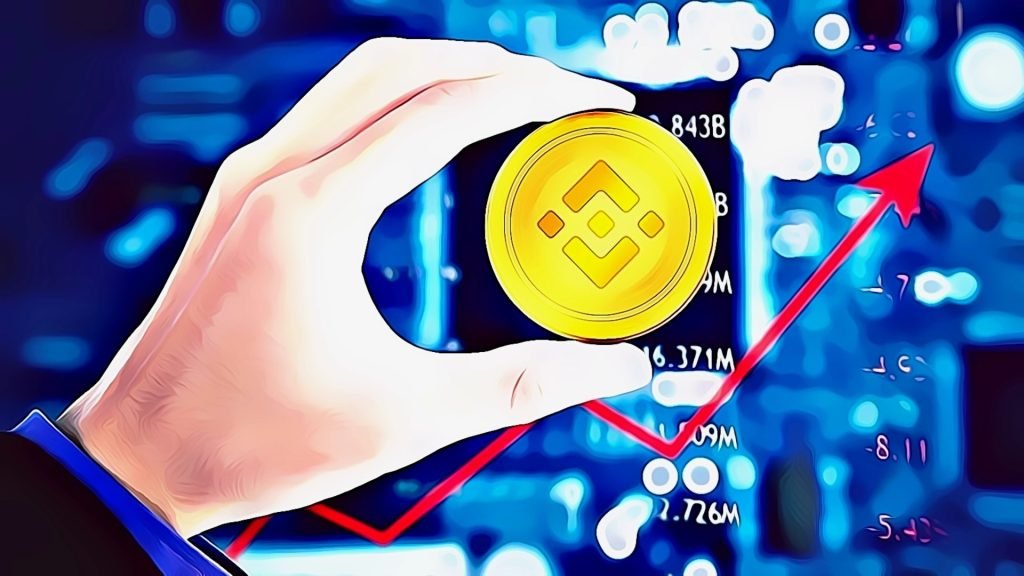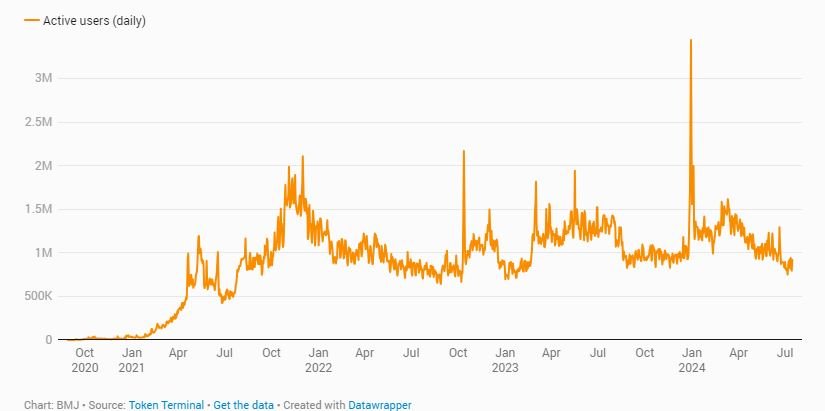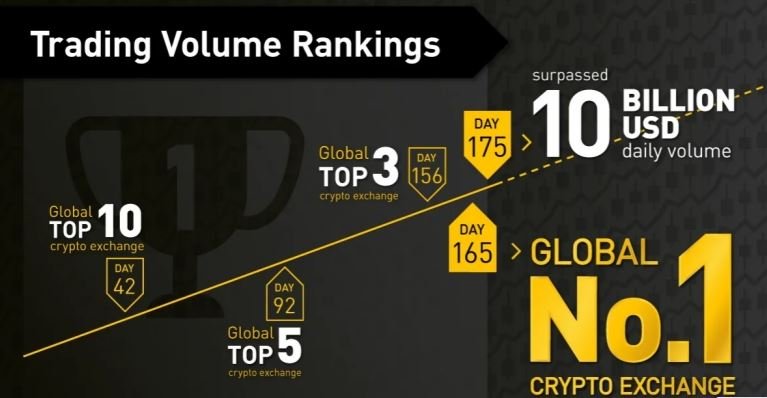At Bitcoin Market Journal, we approach crypto tokens like stocks, analyzing underlying projects as we would traditional companies. While acknowledging their differences, we believe in a diversified portfolio that includes both. Learn more about our investment strategy here.
Binance Coin (BNB): A Beacon of Confidence in a Turbulent Market

BNB’s substantial market capitalization remains a testament to investor trust in Binance as the industry’s leading crypto exchange. While regulatory hurdles persist, Binance’s proactive compliance efforts and unwavering user base provide a sturdy foundation for BNB. As an integral part of Binance’s expanding ecosystem, BNB is well-positioned to reap the rewards of the platform’s continued growth.
The Binance Story
Narratives are the cornerstone of investor memory when it comes to crypto enterprises. While Binance’s inception dates back to 2017, the saga truly commences with its visionary founder, Changpeng Zhao, universally recognized as CZ. Hailing from China, CZ’s odyssey to Canada at the tender age of twelve ignited a lifelong fascination with technology. Following a computer science degree, his professional journey led him to Bloomberg in 2001. By 2005, the entrepreneurial spirit within him materialized, resulting in the birth of an IT startup specializing in trading system development for stockbrokers.
CZ’s rendezvous with cryptocurrency occurred fortuitously in 2013 during a poker game. Captivated by bitcoin’s potential, his immersion in blockchain and cryptocurrencies deepened to such an extent that he made the audacious decision to liquidate his apartment to invest in bitcoin. Fast forward to 2017, and the stage was set for CZ to establish Binance and introduce BNB through an initial coin offering (ICO). Initially conceptualized as a discount mechanism for trading fees, BNB rapidly evolved into an indispensable component of the Binance platform and broader ecosystem.
By 2018, a mere six months after its launch, Binance had ascended to the zenith as the world’s most voluminous cryptocurrency exchange.
Binance’s aggressive global expansion strategy inevitably drew the attention of regulators worldwide. A cascade of warnings and operational restrictions were imposed by various countries. The year 2023 marked a pivotal moment as Binance confronted its most formidable regulatory challenge yet: a lawsuit initiated by the U.S. Securities and Exchange Commission (SEC) against the company and its CEO, CZ. The SEC leveled severe allegations, including unregistered securities offerings, mismanagement of investor funds, market manipulation, violation of customer restrictions, and deceptive practices regarding market surveillance.
In response to these unprecedented challenges, Binance underwent a leadership transition with the resignation of CZ and the appointment of Richard Teng as CEO (refer to our in-depth analysis of Binance’s future under Richard Teng). The company embarked on a comprehensive overhaul of its compliance framework, fostering collaboration with U.S. authorities, and implementing stringent Anti-Money Laundering (AML) and Know Your Customer (KYC) protocols.
A Beacon of User Engagement in the Crypto Realm
Metrics are the lifeblood of our investment analysis. We prioritize user retention and genuine revenue generation in our evaluation of crypto companies.
Binance Coin (BNB) boasts an average of approximately 830,000 Daily Active Users (DAU) according to TokenTerminal, marking a year-over-year decline of 39%. Despite this contraction, BNB maintains a commanding lead over crypto titans such as bitcoin (380,000 DAU) and Ethereum (432,000 DAU) in terms of user engagement.
Binance has established a robust and sustainable revenue model centered primarily on transaction fees. According to former CEO Changpeng Zhao, a staggering 90% of the company’s earnings are derived from these fees. This income stream encompasses a variety of charges, including purchase fees (varying by payment method), trading commissions, and withdrawal fees.
BNB reigns supreme as the cryptocurrency exchange token with the largest market capitalization, boasting a valuation exceeding $77 billion. This places it in the elite company of BTC, ETH, and USDT in terms of overall market dominance. Since the dawn of 2023, BNB’s market cap has witnessed a remarkable surge, more than doubling in value and significantly eclipsing rival exchange tokens such as LEO, CRO, and OKB.
Binance: A Deep Dive into Market Dynamics

Understanding the market’s magnitude, growth trajectory, and customer demographics is paramount. Binance addresses core crypto market challenges, including liquidity, diverse asset accessibility, user-friendly platforms, and innovative financial instruments. Catering to both novice and seasoned investors, Binance offers a comprehensive suite of products encompassing futures trading, staking, and savings accounts.
With a user base surpassing 200 million, primarily composed of tech-savvy males aged 25 to 34, Binance enjoys a dominant market presence. While the platform initially attracted individual investors, institutional participation has surged, accounting for a substantial portion of the user base. Despite a diverse geographic footprint, Russia and Turkey emerge as key markets.
Binance delivers exceptional value through unparalleled liquidity, a vast array of cryptocurrencies, and access to lucrative financial products. The centralized crypto exchange landscape, though mature, positions Binance as the undisputed leader, outperforming rivals like Coinbase with a staggering $12 billion in 2022 revenue. As crypto adoption accelerates, Binance is poised to capitalize on its market dominance and extensive user base.
However, Binance’s prominence also renders it a prime target for regulatory scrutiny. The SEC lawsuit highlights the company’s exposure to regulatory risks, including the potential classification of BNB as a security.
Binance: Forging a Competitive Edge
Assessing a company’s competitive moat involves evaluating its ability to fend off rivals.
BNB, initially deployed on Ethereum, now thrives on its proprietary blockchain, Binance Smart Chain (BSC), which debuted in 2018. BSC has solidified its position as the third-largest blockchain in terms of Total Value Locked (TVL) with an impressive $4.4 billion.
While not a pioneer in the crypto exchange domain, Binance’s meteoric rise to the top of the industry is a testament to its competitive prowess. The company has maintained its market leadership since inception.
Binance’s status as a global crypto behemoth grants it unparalleled access to industry key players. Strategic appointments and high-profile partnerships underscore the company’s networking capabilities.
Binance Leadership: A Blend of Experience and Controversy
Evaluating a company’s success hinges on the caliber of its leadership team. Binance boasts a formidable leadership and entrepreneurial core. Currently helmed by Richard Teng, a key contributor to Binance’s Singapore operations and a seasoned financial regulator, the team demonstrates a blend of industry expertise and regulatory acumen.
The team’s ability to propel Binance to the pinnacle of the crypto exchange industry is undeniable. However, the SEC lawsuit casts a shadow over the company’s adherence to regulatory norms and overall business integrity.
BNB Token: A Cornerstone of the Binance Ecosystem

Understanding a token’s mechanics is crucial for long-term investment success. BNB, an integral component of the Binance ecosystem, transcends the role of a typical exchange token. Beyond offering discounts and incentives to exchange users, BNB has been seamlessly integrated into the Binance Smart Chain (BSC), functioning as its native utility token.
While Binance operates as a centralized entity, certain products like BSC exhibit decentralized characteristics. However, its financial offerings remain centralized. Initially boasting a supply of 200 million tokens, BNB’s circulating supply has dwindled to 147,583,017 due to Binance’s quarterly burn mechanism.
BNB’s widespread availability on major exchanges like Binance, KuCoin, and OKX ensures liquidity and accessibility. The platform, in conjunction with its BNB token, has been operational since 2017, establishing a proven track record.
BNB: Riding the Wave of User Adoption
Assessing a company’s user acquisition potential is crucial for investment success. Binance’s user-friendly interface and extensive global accessibility have solidified its position as the preferred platform for both crypto novices and seasoned traders. Aggressive marketing campaigns, including high-profile celebrity endorsements, have further fueled user growth.
BNB benefits significantly from the halo effect associated with its parent company, Binance. The coin has become an inseparable part of the Binance ecosystem. With a substantial social media following, boasting over 11.8 million Twitter followers and a thriving Reddit community of 960k members, BNB consistently generates significant buzz.
Binance: Navigating the Risk Landscape
Identifying potential risks is essential for prudent investment decisions. Binance boasts a seasoned team with a proven track record in the industry. However, the SEC’s 2023 allegations of customer fund mismanagement and self-enrichment have cast a shadow over the company’s integrity.
Binance’s proof of reserves reports claim full backing of customer assets, suggesting a healthy financial position. Yet, the specter of regulatory uncertainty and reputational damage looms large.
Binance: A Complex Regulatory and Competitive Landscape
Navigating the regulatory landscape is a persistent challenge for Binance, exacerbated by its industry-leading position. The SEC lawsuit alleging BNB’s security status underscores this risk.
Binance has implemented robust security measures, including audits by reputable firms and a substantial bug bounty program. The platform’s longevity and resilience to hacks, crises, and regulatory challenges attest to its battle-tested nature.
Binance’s user acquisition prowess is evident in its blockchain’s impressive 800k daily users and its dominant social media presence. Investor behavior suggests a belief in Binance’s long-term industry relevance, transcending short-term greed.
However, the company’s outsized influence and the evolving regulatory environment pose ongoing challenges.
Binance and BNB: A Promising Outlook Amidst Regulatory Challenges
Binance has cultivated a substantial user base and constructed a multifaceted ecosystem. The company’s reliance on transaction fees ensures a steady and scalable revenue stream, poised to expand with increased trading activity. As an indispensable component of Binance’s ecosystem, BNB is well-positioned to capitalize on the company’s growth trajectory.
Nevertheless, Binance remains ensnared in a complex web of regulatory scrutiny from global authorities. These regulatory challenges pose significant risks, with potential consequences ranging from operational restrictions and financial penalties to reputational damage, ultimately impacting BNB’s value.
Our analysts accord BNB a rating of 4 out of 5, acknowledging its robust market presence and industry experience while remaining mindful of the challenges it confronts. This analysis serves as a catalyst for informed investment decisions, not as a definitive investment recommendation. Thorough independent research is paramount, as future market dynamics may diverge from historical trends. Investing inherently involves risk, necessitating a diversified approach to mitigate potential losses. Prudent investors should allocate capital commensurate with their risk tolerance and view setbacks as opportunities for learning and growth.




